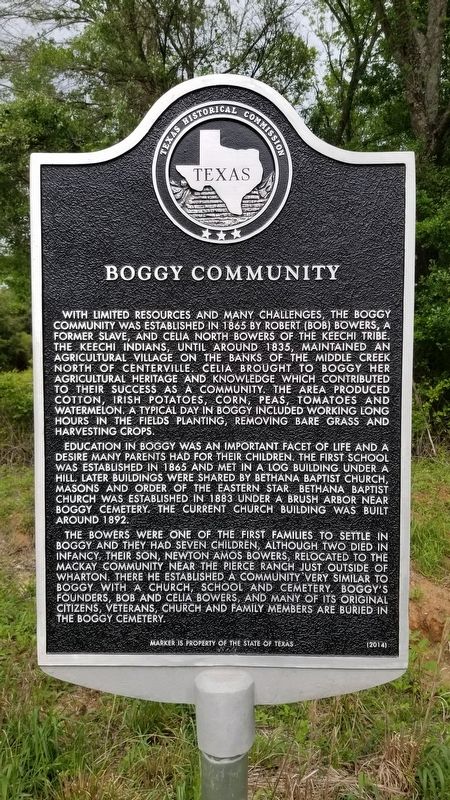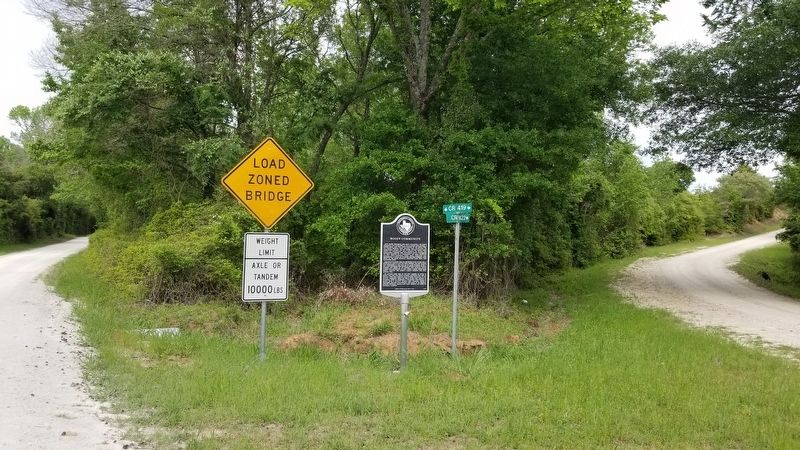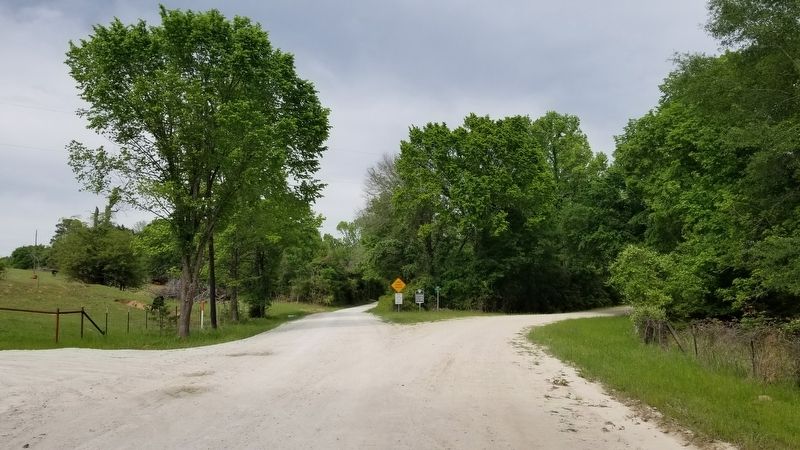Near Flynn in Leon County, Texas — The American South (West South Central)
Boggy Community
With limited resources and many challenges, the Boggy Community was established in 1865 by Robert (Bob) Bowers, a former slave, and Celia North Bowers of the Keechi tribe. The Keechi Indians, until around 1835, maintained an agricultural village on the banks of the Middle Creek north of Centerville. Celia brought to Boggy her agricultural heritage and knowledge which contributed to their success as a community. The area produced cotton, Irish potatoes, corn, peas, tomatoes and watermelon. A typical day in Boggy included working long hours in the fields planting, removing bare grass and harvesting crops.
Education in Boggy was an important facet of life and a desire many parents had for their children. The first school was established in 1865 and met in a log building under a hill. Later buildings were shared by Bethana Baptist Church, Masons and Order of the Eastern Star. Bethana Baptist Church was established in 1883 under a brush arbor near Boggy Cemetery. The current church building was built around 1892.
The Bowers were one of the first families to settle in Boggy and they had seven children, although two died in infancy. Their son, Newton Amos Bowers, relocated to the Mackay Community near the Pierce Ranch just outside of Wharton. There he established a community very similar to Boggy with a church, school and cemetery. Boggy's founders, Bob and Celia Bowers, and many of its original citizens, veterans, church and family members are buried in the Boggy Cemetery.
Erected 2014 by Texas Historical Commission. (Marker Number 17918.)
Topics. This historical marker is listed in these topic lists: African Americans • Agriculture • Native Americans • Settlements & Settlers. A significant historical year for this entry is 1865.
Location. 31° 10.281′ N, 96° 6.593′ W. Marker is near Flynn, Texas, in Leon County. Marker is at the intersection of County Highway 419 and County Highway 422, on the right when traveling east on County Highway 419. Touch for map. Marker is in this post office area: Flynn TX 77855, United States of America. Touch for directions.
Other nearby markers. At least 8 other markers are within 10 miles of this marker, measured as the crow flies. Concord Missionary Baptist Church (approx. 6.1 miles away); Fort Boggy (approx. 7 miles away); Site of Fort Boggy (approx. 7.7 miles away); Leon County (approx. 8.1 miles away); Site of the First Court House Built in Leon County (approx. 8.4 miles away); Kings Highway Camino Real — Old San Antonio Road (approx. 9.1 miles away); a different marker also named Kings Highway Camino Real — Old San Antonio Road (approx. 9.3 miles away); First United Methodist Church of Centerville (approx. 9.7 miles away).
Credits. This page was last revised on April 23, 2021. It was originally submitted on April 22, 2021, by James Hulse of Medina, Texas. This page has been viewed 783 times since then and 42 times this year. Photos: 1, 2, 3. submitted on April 22, 2021, by James Hulse of Medina, Texas.


